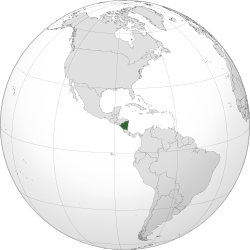
Back Nikaragua ACE Никарагуа ADY Nicaragua Afrikaans Nicaragua ALS ኒካራጓ Amharic Nicaragua AMI Nicaragua AN Nicānlond ANG निकारागुआ ANP نيكاراغوا Arabic
Republic of Nicaragua República de Nicaragua | |
|---|---|
| Motto: En Dios Confiamos (Spanish) "In God We Trust" [1] | |
| Anthem: Hail to Thee, Nicaragua | |
 | |
| Capital and largest city | 12°9′N 86°16′W / 12.150°N 86.267°W |
| Official languages | Spanish |
| Recognised regional languages |
|
| Ethnic groups (2011[2]) |
|
| Demonym(s) |
|
| Government | Unitary presidential constitutional republic |
| Daniel Ortega (FSLN) | |
| Rosario Murillo | |
| Legislature | National Assembly |
| Independence from Spain, Mexico and the Federal Republic of Central America | |
• Declared | 15 September 1821 |
• Recognized | 25 July 1850 |
• from the First Mexican Empire | 1 July 1823 |
• from the Federal Republic of Central America | 31 May 1838 |
• Revolution | 19 July 1979 |
• Current constitution | 9 January 1987 |
| Area | |
• Total | 130,375 km2 (50,338 sq mi) (97th) |
• Water (%) | 7.14 |
| Population | |
• 2023 estimate | 7,046,310 hab (85th) |
• Density | 51/km2 (132.1/sq mi) (155th) |
| GDP (PPP) | 2012 estimate |
• Total | $26.666 billion[3] |
• Per capita | $4,458[3] |
| GDP (nominal) | 2012 estimate |
• Total | $10.506 billion[3] |
• Per capita | $1,756[3] |
| Gini (2007) | 40.1 medium |
| HDI (2012) | medium · 129th |
| Currency | Córdoba (NIO) |
| Time zone | UTC−6 (CST) |
| Date format | dd.mm.yyyy |
| Driving side | right |
| Calling code | +505 |
| ISO 3166 code | NI |
| Internet TLD | .ni |
Nicaragua is a country in Central America. It is officially called the Republic of Nicaragua (Spanish: República de Nicaragua). It has a size of 129,494 square kilometres. It is the largest country in Central America. It borders Honduras to the north and Costa Rica to the south. The capital of the country is Managua. Managua is the third-largest city in Central America. It is also the biggest city of Nicaragua. Almost a quarter of the population lives in the capital city.
The population of Nicaragua is approximately 6 million. The population is multicultural. The population includes indigenous native tribes from the Miskito Coast, Europeans, Africans, and Asians. The main language is Spanish. Some native tribes on the eastern coast speak their native languages. Some of these languages are Miskito, Sumo, and Rama. Some people speak English Creole. Creole is a curious mix-match of English, Dutch, French, Portuguese and Spanish. It dates back to the days when pirates hid out among the islands and cays that make up the coastline. The mixture of cultures has created diversity in art and literature. Some famous Nicaraguan writers are Rubén Darío, Ernesto Cardenal, and Gioconda Belli.[5] The International Poetry Festival held each February in Granada attracts poets and fans from all over the world. Unlike the majority of Latin American countries, Nicaraguans do not see soccer as their main sport. Baseball is king here, an influence from the years of United States occupation in the early 20th century. Music in Nicaragua is the same as elsewhere in the region. The traditional Latin styles like salsa and meringue rule. The Caribbean side has its own Caribbean Island vibe, as well as the traditional Garifuna Punta style.[6]
The biological diversity, warm tropical climate, and active volcanoes make Nicaragua an increasingly popular tourist destination.[7][8]
- ↑ As shown on the Córdoba (bank notes and coins); see, for example, Banco Central de Nicaragua.
- ↑ "Nicaragua Demographics Profile 2011". Nicaragua. Index Mundi. 2011. Retrieved 2011-07-16.
- ↑ 3.0 3.1 3.2 3.3 "Nicaragua". International Monetary Fund. Retrieved 2013-05-23.
- ↑ United Nations Development Programme (2013). "Table 1: Human Development index and its components" (PDF). Human Development Report 2013 The Rise of the South: Human Progress in a Diverse World. New York: United Nations. Archived from the original (PDF) on 2012-03-04. Retrieved 2011-07-16.
- ↑ "Nicaragua, Eternal Land of Poets". Elcomercio.pe. Retrieved 2010-06-26.
- ↑ "Culture Of Nicaragua - centralamerica.com". centralamerica. Retrieved 2021-04-01.
- ↑ Dicum, G (2006-12-17). "The Rediscovery of Nicaragua". Travel Section. New York: TraveThe New York Times. Retrieved 2010-06-26.
- ↑ Davis, LS (2009-04-22). "Nicaragua: The next Costa Rica?". Mother Nature Network. MNN Holdings, LLC. Retrieved 2010-06-26.

